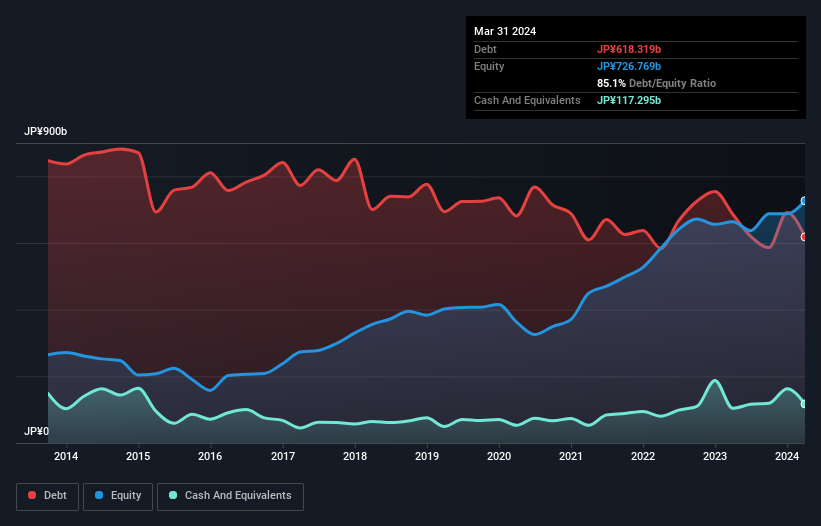Some say volatility, rather than debt, is the best way to think about risk as an investor, but Warren Buffett famously said that ‘Volatility is far from synonymous with risk.’ It’s only natural to consider a company’s balance sheet when you examine how risky it is, since debt is often involved when a business collapses. As with many other companies Cosmo Energy Holdings Co., Ltd. (TSE:5021) makes use of debt. But the real question is whether this debt is making the company risky.
Why Does Debt Bring Risk?
Debt is a tool to help businesses grow, but if a business is incapable of paying off its lenders, then it exists at their mercy. If things get really bad, the lenders can take control of the business. While that is not too common, we often do see indebted companies permanently diluting shareholders because lenders force them to raise capital at a distressed price. By replacing dilution, though, debt can be an extremely good tool for businesses that need capital to invest in growth at high rates of return. When we think about a company’s use of debt, we first look at cash and debt together.
See our latest analysis for Cosmo Energy Holdings
How Much Debt Does Cosmo Energy Holdings Carry?
The chart below, which you can click on for greater detail, shows that Cosmo Energy Holdings had JP¥618.3b in debt in March 2024; about the same as the year before. However, because it has a cash reserve of JP¥117.3b, its net debt is less, at about JP¥501.0b.

How Strong Is Cosmo Energy Holdings’ Balance Sheet?
Zooming in on the latest balance sheet data, we can see that Cosmo Energy Holdings had liabilities of JP¥1.01t due within 12 months and liabilities of JP¥477.5b due beyond that. On the other hand, it had cash of JP¥117.3b and JP¥496.4b worth of receivables due within a year. So it has liabilities totalling JP¥871.5b more than its cash and near-term receivables, combined.
Given this deficit is actually higher than the company’s market capitalization of JP¥638.2b, we think shareholders really should watch Cosmo Energy Holdings’s debt levels, like a parent watching their child ride a bike for the first time. In the scenario where the company had to clean up its balance sheet quickly, it seems likely shareholders would suffer extensive dilution.
We measure a company’s debt load relative to its earnings power by looking at its net debt divided by its earnings before interest, tax, depreciation, and amortization (EBITDA) and by calculating how easily its earnings before interest and tax (EBIT) cover its interest expense (interest cover). Thus we consider debt relative to earnings both with and without depreciation and amortization expenses.
We’d say that Cosmo Energy Holdings’s moderate net debt to EBITDA ratio ( being 2.5), indicates prudence when it comes to debt. And its strong interest cover of 1k times, makes us even more comfortable. Sadly, Cosmo Energy Holdings’s EBIT actually dropped 8.9% in the last year. If earnings continue on that decline then managing that debt will be difficult like delivering hot soup on a unicycle. When analysing debt levels, the balance sheet is the obvious place to start. But it is future earnings, more than anything, that will determine Cosmo Energy Holdings’s ability to maintain a healthy balance sheet going forward. So if you’re focused on the future you can check out this free report showing analyst profit forecasts.
But our final consideration is also important, because a company cannot pay debt with paper profits; it needs cold hard cash. So the logical step is to look at the proportion of that EBIT that is matched by actual free cash flow. In the last three years, Cosmo Energy Holdings’s free cash flow amounted to 27% of its EBIT, less than we’d expect. That’s not great, when it comes to paying down debt.
Our View
We’d go so far as to say Cosmo Energy Holdings’s level of total liabilities was disappointing. But on the bright side, its interest cover is a good sign, and makes us more optimistic. Looking at the bigger picture, it seems clear to us that Cosmo Energy Holdings’s use of debt is creating risks for the company. If all goes well, that should boost returns, but on the flip side, the risk of permanent capital loss is elevated by the debt. There’s no doubt that we learn most about debt from the balance sheet. However, not all investment risk resides within the balance sheet – far from it. To that end, you should be aware of the 1 warning sign we’ve spotted with Cosmo Energy Holdings .
If you’re interested in investing in businesses that can grow profits without the burden of debt, then check out this free list of growing businesses that have net cash on the balance sheet.
New: AI Stock Screener & Alerts
Our new AI Stock Screener scans the market every day to uncover opportunities.
• Dividend Powerhouses (3%+ Yield)
• Undervalued Small Caps with Insider Buying
• High growth Tech and AI Companies
Or build your own from over 50 metrics.
Have feedback on this article? Concerned about the content? Get in touch with us directly. Alternatively, email editorial-team (at) simplywallst.com.
This article by Simply Wall St is general in nature. We provide commentary based on historical data and analyst forecasts only using an unbiased methodology and our articles are not intended to be financial advice. It does not constitute a recommendation to buy or sell any stock, and does not take account of your objectives, or your financial situation. We aim to bring you long-term focused analysis driven by fundamental data. Note that our analysis may not factor in the latest price-sensitive company announcements or qualitative material. Simply Wall St has no position in any stocks mentioned.

